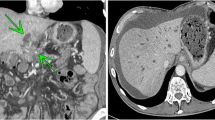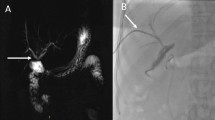Abstract
Background
Ascites is a relative contraindication to percutaneous biliary drainage (PBD), but patients with biliary obstruction presenting with ascites may still undergo PBD insertion. We hypothesized that ascites increases the major complication rate of PBD.
Materials
PBDs placed between January 2005 and August 2016 were identified (n = 491). Etiology and location of obstruction, the presence, and distribution of ascites based on abdominal imaging within 2 weeks of PBD, INR, WBCE, and peri-procedural complications were reviewed in the EMR.
Results
A total of 491 PBD were placed during the study period of which 26.2% had ascites (n = 129), and 73.7% did not have ascites (n = 362). Ascites was categorized as perihepatic in 41 patients (32%), diffuse in 82 patients (64%), and non-perihepatic in 6 patients (4%). Overall, a significantly higher rate of major complications occurred in patients with ascites (19%) compared to that in patients without ascites (7.7%, P = 0.0004). Diffuse ascites was associated with a significantly higher major complication rate (26%) when compared to perihepatic ascites (7.3%, P = 0.014). In ascites patients, no association between the etiology of biliary obstruction or laterality of the PBD and the rate of major complications was identified.
Conclusions
The major complication rate in patients with ascites not only exceeds SIR suggested threshold of 10% but is also significantly higher than that patients without ascites. The distribution of ascites had a significant effect on complication rate, with diffuse ascites being associated with increased major complication rates compared to those with perihepatic. These findings suggest careful consideration of patients for PBD with ascites, particularly diffuse ascites.
Similar content being viewed by others
References
Covey, A.M. and K.T. Brown, Percutaneous transhepatic biliary drainage. Tech Vasc Interv Radiol, 2008. 11(1): p. 14-20.
Saad, W.E., et al., Quality improvement guidelines for percutaneous transhepatic cholangiography, biliary drainage, and percutaneous cholecystostomy. J Vasc Interv Radiol, 2010. 21(6): p. 789-95.
Winick, A.B., P.N. Waybill, and A.C. Venbrux, Complications of percutaneous transhepatic biliary interventions. Tech Vasc Interv Radiol, 2001. 4(3): p. 200-6.
Lucatelli, P., et al., Risk Factors for Immediate and Delayed-Onset Fever After Percutaneous Transhepatic Biliary Drainage. Cardiovasc Intervent Radiol, 2016. 39(5): p. 746-55.
Lucatelli, P., et al., Risk Factors for Immediate and Delayed-Onset Fever After Percutaneous Transhepatic Biliary Drainage. Cardiovasc Intervent Radiol, 2016. 39(5): p. 746-55.
Tapping, C.R., O.R. Byass, and J.E. Cast, Percutaneous transhepatic biliary drainage (PTBD) with or without stenting-complications, re-stent rate and a new risk stratification score. Eur Radiol, 2011. 21(9): p. 1948-55.
Duncan, C., et al., Outcomes of Percutaneous Cholecystostomy in the Presence of Ascites. J Vasc Interv Radiol, 2016. 27(4): p. 562-6 e1.
Boulay, B.R. and A. Birg, Malignant biliary obstruction: From palliation to treatment. World J Gastrointest Oncol, 2016. 8(6): p. 498-508.
Jarnagin, W.R., et al., Intrahepatic biliary enteric bypass provides effective palliation in selected patients with malignant obstruction at the hepatic duct confluence. Am J Surg, 1998. 175(6): p. 453-60.
Funaki, B., et al., Percutaneous biliary drainage in patients with nondilated intrahepatic bile ducts. AJR Am J Roentgenol, 1999. 173(6): p. 1541-4.
Saluja, S.S., et al., Endoscopic or percutaneous biliary drainage for gallbladder cancer: a randomized trial and quality of life assessment. Clin Gastroenterol Hepatol, 2008. 6(8): p. 944-950 e3.
Carrasco, C.H., J. Zornoza, and W.J. Bechtel, Malignant biliary obstruction: complications of percutaneous biliary drainage. Radiology, 1984. 152(2): p. 343-6.
Yee, A.C. and C.S. Ho, Complications of percutaneous biliary drainage: benign vs malignant diseases. AJR Am J Roentgenol, 1987. 148(6): p. 1207-9.
Author information
Authors and Affiliations
Corresponding author
Additional information
Publisher's Note
Springer Nature remains neutral with regard to jurisdictional claims in published maps and institutional affiliations.
Rights and permissions
About this article
Cite this article
Patel, V., McLaughlin, S.W., Shlansky-Goldberg, R. et al. Complication rates of percutaneous biliary drainage in the presence of ascites. Abdom Radiol 44, 1901–1906 (2019). https://doi.org/10.1007/s00261-019-01916-5
Published:
Issue Date:
DOI: https://doi.org/10.1007/s00261-019-01916-5




